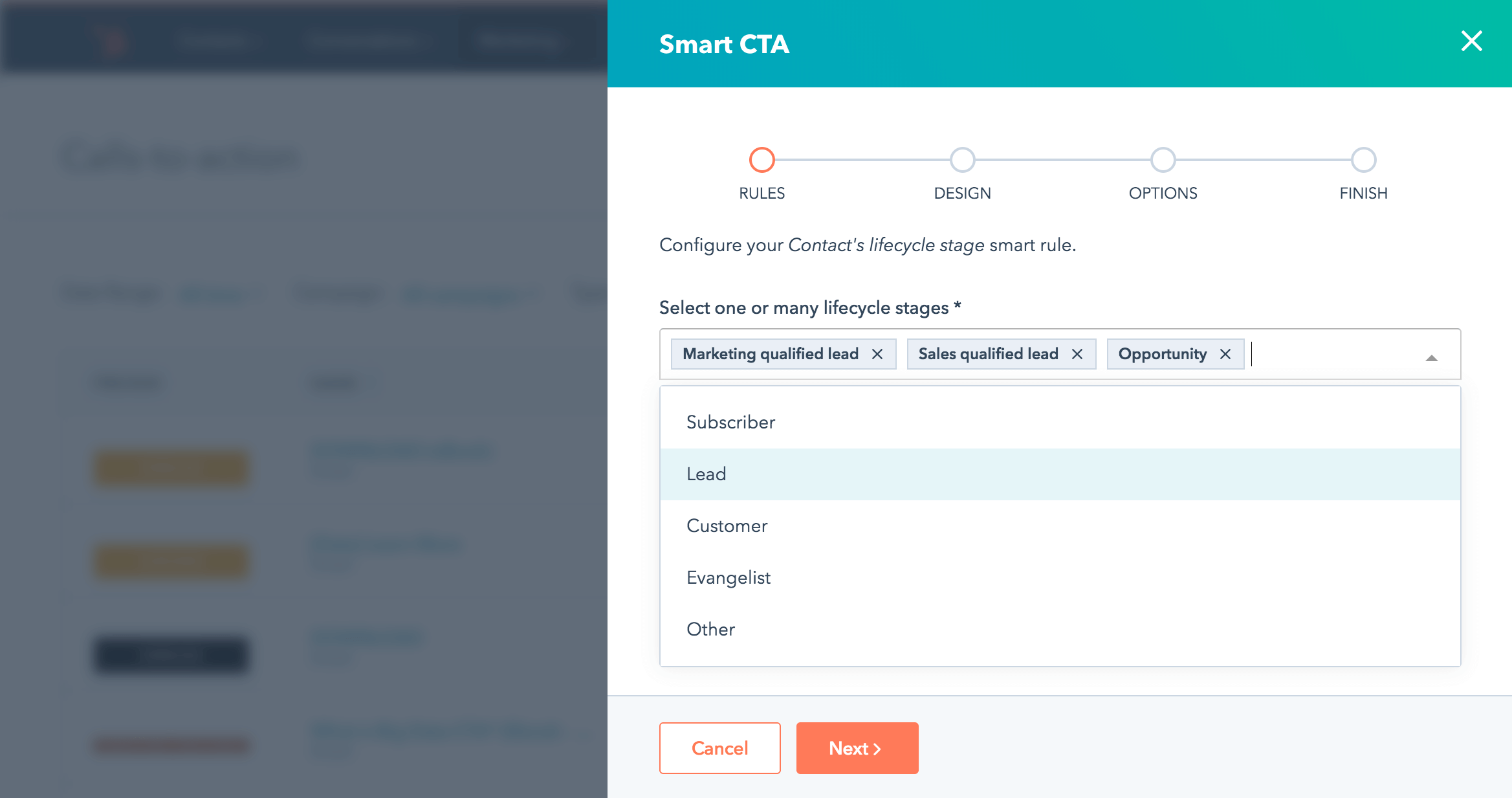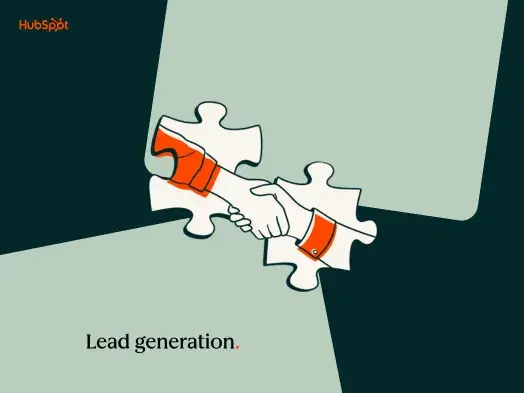1. Audit existing blog metrics.
To develop a process for growing our blog lead number, we first needed an understanding of how well we were performing.
To capture the current state of blog lead generation, we looked for the overall traffic number and number of leads generated from the blog. These two numbers gave us a baseline conversion rate (in this case, number of leads generated, divided by the total views to the HubSpot Blog in a given time period) from which we knew the team could only go up.
While the number of leads was the ultimate goal for our team, we wanted to take a deeper look at the overall conversion rate and how it changed month-over-month – this number would let us know for sure if we were growing traffic to posts and topics that were most likely to convert their intended audiences.
The big-picture conversion rate gave us an important directional view, but if we ever saw a major shift in that conversion rate, we needed to know where that shift was happening. For example, if we saw a surge in traffic to a low-converting post, that would hinder the overall conversion rate for the blog.
To drill down further, we also looked at all of our post-level data – that is, each post's traffic number, number of leads generated, and CVR. By exporting and tracking this data monthly, we were able to see which posts were dragging down our CVR, which posts were keeping it strong, and which posts were prime candidates for a better CVR.
How to complete this step:
- Choose a time period (last quarter, last month, etc.) for which you want to know your conversion metrics.
- Determine your overall data for traffic and leads generated in this time and calculate overall blog CVR.
- Export your traffic and lead numbers for individual blog posts for this time period. Depending on your analytics tool, this may require you to export data from two different sources and combine metrics using a VLOOKUP on Excel or Google Sheets.
- For each post, divide the number of leads it generated by its traffic number to get post-level conversion metrics.
For a quick video overview on more HubSpot Blog lead generation tips like this, check out our video guide.
2. Group common posts together.
Over the years, HubSpot has published thousands of blog posts – and while this was immensely helpful for growing HubSpot's email subscription base and ranking for countless keywords, it made the process of organizing and analyzing conversion metrics extremely difficult.
Luckily, the blog and SEO teams developed a model to group posts with similar search intent with the pillar-cluster model. In a nutshell, this model was the result of a massive audit to better organize our blog, reduce redundancy on the blog, and help search engines understand which pieces of content we wanted to be considered the most authoritative on a given subject.
As a result of this project, all of our blog posts were given a relevant "topic tag" – or the cluster for which each post belonged. For instance, any Instagram post is assigned an "Instagram Marketing" tag, and links back to our Instagram Marketing pillar page.
This process ensures effectiveness when analyzing metrics. For instance, when exporting blog metrics, we can analyze blog posts by tag (i.e. all "Instagram Marketing" posts), of which we have a few hundred — rather than analyzing each individual URL, of which we have over 10,000.
How to complete this step:
- Export all of your blog posts from your CMS or website analytics tool onto a spreadsheet.
- Categorize each of your keywords into a topic cluster. These topic clusters should be high in search volume, anchored by a long and high-trafficked post, and related to each other when it comes to search intent. For example, rather than put all of our posts on social media in one giant “Social Media” cluster, we created more niche clusters for Facebook, Twitter, LinkedIn, and Instagram to help us categorize with more specificity.
- With each post properly categorized, organize your data with a pivot table to look at the numbers generated by each cluster rather than each URL. Your pivot table should include the number of posts in each cluster, the views generated, and the leads generated. From there, you can calculate the cluster's CVR by dividing total leads by total views.
3. Determine the best content offer opportunities.
One of the major benefits of grouping your posts together is identifying a content offer opportunity that can be effectively promoted on multiple blog posts, as opposed to an individual post.
As acquisition marketers, it's tempting for us to attempt optimizing the conversion paths for high-traffic posts. However, these high-traffic posts are oftentimes too general and unrelated to what it is we're trying to market.
This mismatch results in misplaced efforts and unmet lead goals, as we're quick to ignore blog posts which – on their own – may have lower traffic numbers, but together have a substantial traffic number.
Ask yourself – which of these two options is a better pursuit for lead generation?
- A blog post that has little or nothing to do with your products or services, but is viewed 100,000 times a year.
- 10 individual blog posts that have a clear connection to your company's core competencies, but on average generate only 10,000 views each per year.
In either scenario, you'd be optimizing the conversion path for 100,000 readers – it's only by grouping these posts together that you'd realize option #2 is a much better option for lead generation.
To address this issue, we organized all of our blog topics by the potential number of leads they could generate, but readily discounted any topic cluster of which we doubted the conversion potential. This crucial step ensured we only considered ideas that we believed would be worth our time and resources to create.
Along with dedicated CTAs for each blog post we create, we also create featured resources for certain topics we believe have high conversion potential. For instance, in this Ebook Format blog post, we created a special featured resource, 18 Free Ebook Formatting & Creation Templates:
How to complete this step:
- Calculate how many leads each topic cluster could be generating. At HubSpot, we do this by subtracting each cluster's actual CVR from its target CVR, and multiplying that difference by the traffic number for the desired time period.
- Organize data by each cluster's lead generation opportunity – looking first at the highest opportunity and at the lowest opportunity last.
- Work through your list of high-opportunity clusters and remove any low-intent clusters from your consideration, ensuring you're only left with topic clusters that have a direct connection to your products/services.
- Select one (or many) topic clusters which you want to support with a lead-generating content offer.
4. Create lead-generating content.
By this point, you've identified topic clusters which you feel would benefit from a new, dedicated piece of lead generating content. Now, it's time to create that piece of content.
Understanding what kind of content to create comes from knowledge of your industry, your market, and your buyer personas. In our experience, we discovered HubSpot's Blog audience responds to actionable, personalized, and customizable content in the form of templates, tools, and kits.
However, this is not the case for all organizations – so figure out which content format works best for your audience by auditing the performance of your current library or testing out different formats to see what resonates with your blog readers.
With the knowledge of what formats work best for our readership, we got to work on creating templates for our most-read but lowest-converting clusters, so that readers would see our content as an actionable next step for them to apply the knowledge they gained in the blog post. Below are a few examples of how we mapped an offer to a topic cluster.
|
Blog Topic Cluster |
Content Offer |
|
Customer Experience |
|
|
Sales Training |
|
|
Product Marketing |
|
|
Pricing Strategy |
|
|
Facebook Advertising |
The most important thing to remember during this step is to not overcomplicate your content. Remember, to secure a conversion, you need to convince a reader of your content's quality and relevance. If you're struggling to make the connection between your blog content and your offer's content yourself, how well do you think a reader skimming your blog posts will make that connection?
How to complete this step:
- Look through the posts in the topic cluster you want to optimize with new content and think about what a natural next step would be for the reader.
- Cement an idea for a piece of content you can create that aids your readers in that next step.
- Create the content in your desired format (PDF for ebooks, Google Sheets or Microsoft Word for templates, etc.) and launch it behind a lead-generating form on your website.
5. Promote content with CTAs.

HubSpot's CTA tool enables you to create CTAs and personalize them to each visitor.
To facilitate a blog conversion, you'll need to let blog readers know about the new lead-generating piece of content on the same page as your blog content.
Blog CTAs can take a variety of formats. Two of the most popular are:
- Anchor Text CTAs – Hyperlinked text to the landing page of the offer you're promoting. Remember to keep anchor text direct and clear so readers know what they're clicking – action words like “download” and “access” are useful here.
- Image CTAs – Hyperlinked images to your offer's landing page. These CTAs might look like a banner ad and contain an image of the offer alongside copy explaining the value of it. These image CTAs could also be an image of the offer itself, which makes sense if promoting a template or a tool.
At HubSpot, the majority of our posts contain at least three CTAs – one anchor text, and two image. Depending on the intent we expect readers have on a specific post, we may include several more. However, all of these decisions are based on years of data collection and A/B testing – which we encourage you to rely on as well to ensure a non-intrusive CTA experience on your blog posts.
How to complete this step:
- Determine the CTA types you want to include for the blog posts you're optimizing.
- If necessary, create CTA imagery with a design tool like Adobe or Canva.
- Add CTAs to each post, either by utilizing a CTA tool or hyperlinking each image or line of text you add into your blog posts. We recommend the former.
6. Analyze your results.
We gained confidence that this approach worked best for us when the results confirmed so.
After 30 days of launching a new content offer on a series of blog posts, we always answer two questions:
- How many leads did each blog generate before we optimized it with the new content offer?
- How many leads did each blog generate after we optimized it with the new content offer?
Far more often than not, these clusters see a notable increase in CVR, with some increasing by more than 1,000%.
However, there have been times where we missed the mark and the offer did not perform as expected. When that was the case, we reverted the changes and went back to the drawing board – equipped with the knowledge of what didn't work, which helped us determine what would help us generate more leads in the future.
How to complete this step:
- Calculate the traffic, lead, and CVR numbers for each blog post optimized with the new offer before swapping out the CTA.
- Calculate the same for a set time period after the CTAs were swapped.
- Calculate the difference in leads and in CVR for each post.
- If the post did not increase in CVR as expected, consider reverting your changes and creating a new content offer.
7. Align with SEO.
When we discovered that this process was helping us hit our goals, our immediate thought was protection. HubSpot writers and SEOs work hard to ensure our blog posts continuously rank on the first page for the search results of their intended keywords — and we don't want to lose that hard-fought real estate.
However, like all teams, SEO needs to prioritize which blog posts are most in need of protection from losing their SERP rankings and traffic – so it became our job to ensure HubSpot's SEO team knew which posts were most important when it came to generating leads.
We're fortunate here at HubSpot to work with expert SEOs who are able to quickly and effectively prioritize the right content.
As my colleague Braden Becker – HubSpot Senior SEO Strategist – said when we spoke about this topic at INBOUND 2020, "Traffic doesn't pay the bills."
Once we were all on-board regarding prioritization, our teams came to an agreement on how to best manage an SEO strategy for high lead-drivers while respecting the importance of maintaining high traffic numbers for posts across the HubSpot Blog.
The team takes the following steps to ensure lead generation goals are met:
- Protect the traffic to high-traffic, high-converting blog posts by regularly checking performance and making as-needed updates to the content of these posts. By frequently optimizing these posts, we let search engines know we're quick to add the most relevant information onto these pages.
- Grow the traffic to low-traffic, high-converting blog posts – or ensure that these posts have maxed out their organic traffic potential.
- Create posts for keywords that we have not written articles for – but align with related content offers or clusters – as these posts could generate substantial lead numbers for us. This step requires keyword research to ensure these new posts generate traffic.
- Stop protecting traffic to high-traffic, low-converting posts. While strong traffic numbers are great, we came to the conclusion that a lower traffic number is acceptable if it means redirecting our historical optimization efforts away from posts that might not generate as much traffic, but will generate significantly more leads than other posts.
How to complete this step:
- Come up with a list of blog content that you'd like to see an increase or decrease of traffic to for lead-generation purposes.
- Present this list to your colleague(s) in SEO to determine what work can be done to redirect traffic growth efforts to the right posts. Note: it's important to set expectations here, as an SEO cannot wave a magic wand and increase demand for a low-ranking keyword. Sometimes, a post is ranking as well as it can be – but that doesn't mean you shouldn't double check to see if there's opportunity to grow traffic where possible.
- Present a list of high-traffic, high-converting blog content to see if there are similar keywords which could be written about in a new (or updated) blog post, in addition to potential keywords that could be the basis for net new posts.
- Come with data. SEOs aren't in the business of risk-taking, so explain how a sacrifice of traffic in some areas could result in a stronger CVR and higher lead number from your company's blog.
8. Repeat the cycle!
HubSpot's bloggers are always creating new blog posts and historically optimizing existing ones. In other words, my team is always presented with opportunities to create new lead-generating content and ensure the content we've already made still holds up and is of value to our leads.
Whenever we create a piece of gated content, we always follow the seven steps above, and we're consistently rewarded with an increase in leads from our blog.
Lead Generation




![What is a lead magnet? 20 lead magnet ideas and examples [+ step-by-step]](https://53.fs1.hubspotusercontent-na1.net/hubfs/53/lead%20magnet%20represented%20by%20a%20magnet.webp)




![Gated Content: What Marketers Need to Know [+ Examples]](https://53.fs1.hubspotusercontent-na1.net/hubfs/53/UNGated%20Content.png)

![What Is Demand Generation? Here’s How You Can Create Buzz for Your Offering [FAQs]](https://53.fs1.hubspotusercontent-na1.net/hubfs/53/demand-generation-1-20250321-225687.webp)

